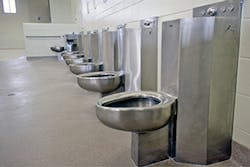The average cost of confinement across the country is approaching $30,000 a year for each prisoner, says Tommy Norris, who operates www.greenprisons.org. The most recent US Department of Justice prison population count places it at 2.1 million.
“That makes prison an extremely expensive operation for the taxpayer short-term and long-term, and virtually everything you have in a small city you have in a prison—from the food service to the laundry to the fire department—and nearly all of those functions consume utilities, including water,” notes Norris.
While one may assume that an inmate wouldn’t have cause to use any more water than the person who is not incarcerated, statistics reveal otherwise: the average person uses between 80–100 gallons of water per day and prisoners use 120–149 gallons per day. The reason: because they can.
In a prison, there is little that an inmate can control, points out Shawn Bush, president and CEO of I-CON Systems, which manufactures technology Norris regards as the “gold standard” in prison water efficiency.
“They are told when to eat, where to go, when to sleep, and when the lights can go on and off, but they can always control their button on their toilet,” says Bush.
“We have people locked up in prison for making some bad decisions, and just because they’re locked up doesn’t mean they stop making bad decisions,” notes Norris. “Historically, one of the things they’ve been able to control in those cells that have plumbing fixtures is the water. They jam stuff down the toilets, flood the toilets, and flood the range, creating dangerous situations of water overflowing off of the fourth or fifth tier. They want to mess with the staff. They want to demonstrate their angst.”
Inmates may or may not have trash cans, but nonetheless they’ll take food waste or other items and use the toilet as a trash can because they don’t want to have to smell it or deal with it, adds Bush.
“If inmates want to get out of their cell, they’ll clog their toilet and flush it multiple times and they’ll flood their cell to try to get out of their cell,” says Bush. “It’s one way they get to go into the recreational area or move somewhere while someone has to clean their cell out.”
Inmates also will use toilets to flush contraband away during a search.
In addition to water waste, excess flushing also leads to rapid wear and tear on the fixtures and increased maintenance and replacement costs.
There is a growing awareness among correctional facility administrators that is dovetailing with society in general about how valuable a commodity water is and how important it is to control, says Norris.
Six years ago, the American Correctional Association began to take a serious look at the importance of sustainability in the operation of correctional facilities, says Norris. He then started www.greenprisons.org, a nonprofit organization providing training, technical assistance, and information on sustainable practices and products for the correctional community.
Norris is a veteran prison administrator whose career spans work with the Federal Bureau of Prisons, the National Institute of Corrections, various state correctional systems, undergraduate instruction, and chairman of the American Correctional Association’s Clean and Green committee.
Norris considers three factors in correctional facility initiatives. One is that it has to make financial sense. “Ideally, it has to generate money but at the very least, it has to save significant dollars to make it worthwhile,” he says.
His second consideration: whether it will provide opportunities for offenders to learn new skills through training programs that will lead to job opportunities when they are released from prison.
Environmental impact is a third consideration. “The facility administrator is part of a community and has a vested interest in being seen positively by the community,” says Norris. “So when they speak with various community groups, they can talk about the tons of solid waste they’ve diverted from the landfill or their water conservation efforts.”
Depending on the facility’s location, water can rival energy in utility costs, points out Norris. In his home state of Kentucky, electricity is inexpensive compared to water, “which can get pretty pricey,” he adds.
“Add on the wastewater charges that typically are a factor of four on the back end of that,” says Norris. “Administrators are becoming more aware of water conservation in terms of the amount of water they use.”
Sustainability in prisons “checks a lot of the boxes that relate to revenue and financial solvency,” points out Norris. “Nobody is giving us any extra money to run these facilities, many of which are 40 to 100 or more years old and some of the plumbing in them seems like it’s almost that old. Looking for strategies to operate more efficiently is always important.”
